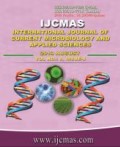


 National Academy of Agricultural Sciences (NAAS)
National Academy of Agricultural Sciences (NAAS)

|
PRINT ISSN : 2319-7692
Online ISSN : 2319-7706 Issues : 12 per year Publisher : Excellent Publishers Email : editorijcmas@gmail.com / submit@ijcmas.com Editor-in-chief: Dr.M.Prakash Index Copernicus ICV 2018: 95.39 NAAS RATING 2020: 5.38 |
Lichen is a combination of two organisms one is alga and another one is fungus. There is symbiotic relationship between alga and fungus. The algal part provides nutrition to the whole organism and the fungus part provides structural support to the organism. Lichens has been used for many purposes in all over the world because lichens have tremendous properties in them due to the presence of various natural compounds known as primary and secondary metabolites which are not known to other group of plants (unique with respect to higher plants), to take the benefit of these properties correct identification of lichens is necessary. Identification of lichen is very difficult task due to the complex structure of lichens, which consumes lot of time. Exploration of these properties is only possible when lichens are identified correctly, properly, easily and on time. Different types of methods are used to identify lichens and these methods are modified day by day to get better results. Taxonomists mainly use three different approaches for identification of lichens (a) Microscopic approaches (b) chemical approaches (c) Molecular approaches. Molecular approaches are the best and fastest approaches to identify the lichens correctly and easily. With the help of information technology and computer applications all the informative data which is collected during identification is compiled and stored in an application in the form of digital library through which one can easily retrieved the data for future use. This helps the taxonomists in identification, characterization and in quick classification of lichens.
 |
 |
 |
 |
 |